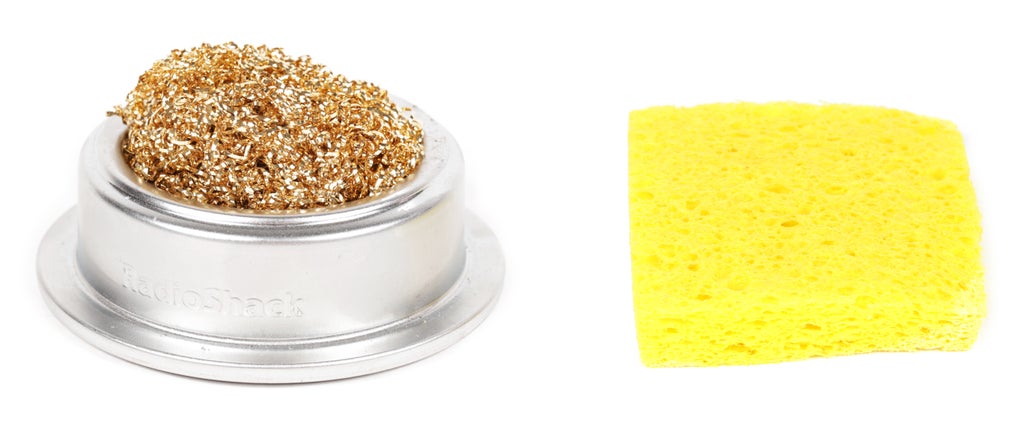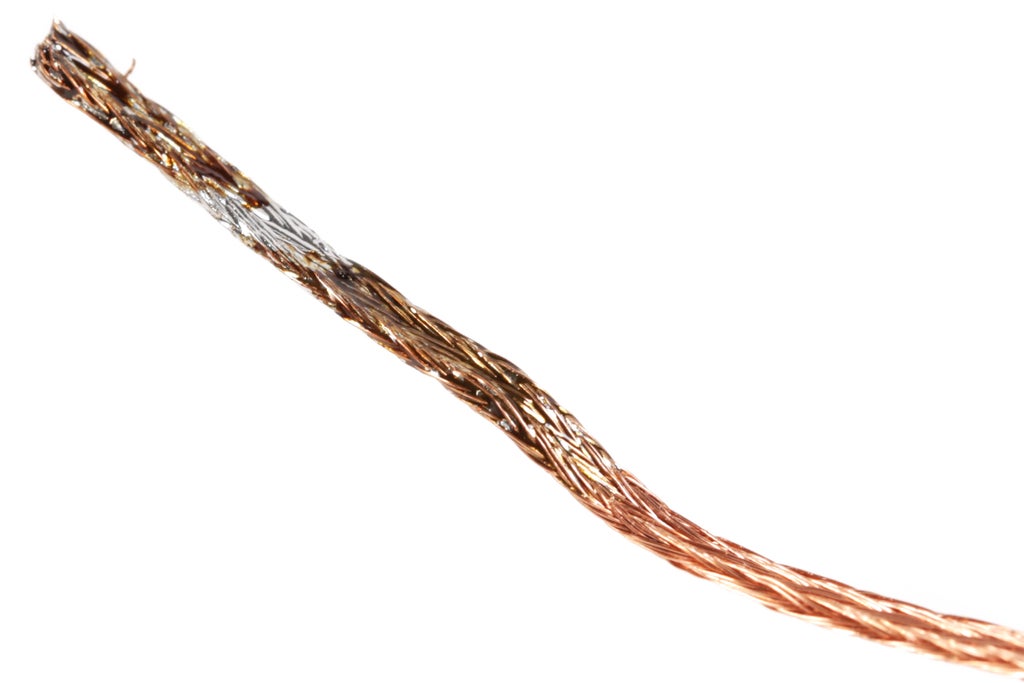Introduction: Soldering
The first thing we will cover before we get into the meat and potatoes of electronic components is soldering.
While you can learn electronics without ever picking up a soldering iron -- in fact, many electrical engineers do -- this is a hands-on electronic class. We are going to be soldering in every lesson along the way. Thus, I am going to get this fundamental skill out of the way from the onset.
This is by no means the definitive guide on soldering, but a brief overview to get you going. By the end of this lesson you should be able to solder with reasonable proficiency.
Step 1: Setting Up Your Workspace

To start, you will want a soldering iron. As a beginner, you can get a 40W fixed temperature soldering iron. These are cheap and will get the job done for what you are doing while you are just getting started. By the time you decide you want to continue deeper into electronics, it will likely be time to upgrade to something more refined.

If you already have some experience soldering, or want to start with the luxury model, you can get an adjustable temperature soldering iron. Having an adjustable temperature is nice because it allows you to work with different types of solder and components with more precision. These soldering irons also typically heat up faster. They also tend to have a much wider array of replaceable tips to work with for all kinds of specialty purposes. As you begin to understand how soldering works, you will eventually want upgrade to one of these.

The two most popular methods for cleaning the tip of the soldering iron involves using a brass wire pad or a slightly damp sponge. Both work. However, deciding which works better is a highly contentious topic. Personally, I feel the the brass wire pad is more effective in quickly cleaning the tip. From what I can tell, advocates of the damp sponge feel it keeps the tip cleaner for longer.

There are two types of wire you should always have on hand when working with electronics. It is highly advised to have both solid and stranded 22AWG wire in red, black and green (or - really - any color not red or black).

Like wire, solder comes in spools and of different thicknesses. The solder I like working with is in the 0.02 - 0.04" range. It is important not to get solder that is too thin because you will have to heat up your parts for too long in order to melt enough solder onto it. It is also important to not get solder that is too thick or you will get too much solder all over the board, which aside from being messy can result in mistakes.
The other choice you need to make is to use solder with (pictured left) or without lead (pictured right). It is recommended that you use lead free solder. However, keep in mind, that just because it is lead free does not mean it is any better for you. Lead free solder has replaced the lead with other additives and actually produces more caustic fumes when melted. Lead free solder also melts at a higher temperature and is harder to work with. On account of this, you might at some point be tempted to work with lead solder. If you do, remember to always wash your hands after handling it!

Desoldering braid is a copper mesh used to remove solder from a circuit board. When the solder gets heated up, the mesh wicks the solder away and helps remove excess. This is particularly helpful for trying to repair soldering mistakes. While this is helpful, it should always be thought of as a line of last defense.

Helping hands is basically a stand with two (or more) alligator clips attached. As the name implies, it is extremely helpful. These are sometimes called a "third hand," and as you can guess by that, this is basically used in those instances when a third (or fourth) hand would be handy. This is particularly useful for holding components in place while soldering. Many come with a magnifying glass, which is great for inspecting solder pads and reading the tiny print on components.

Depending on your ambient lighting, and overall optical dexterity, you may want to consider getting a desk light. Electronic components and solder connections are small. To see things well, it sometimes helps to have more light.

Last, but not least, you will want a fan or some other form of ventilation. I highly recommend one like the one pictured, with an activated charcoal filter. This will not only suck the air away from you, but filter out some of the particulates from continuing to circulate in the room.
Step 2: Holding the Soldering Iron
A soldering iron is held like a pencil, but with one significant difference. Instead of holding it by the tip, you hold the soldering iron further back by the insulated handle.
That's all there is to that.
Step 3: Safety Concerns

Never touch the metal part of the soldering iron while it is turned on. This can result in nasty burns, and is generally unpleasant.

Never leave soldering iron resting on the table. It will burn your work surface and could potentially start a fire.

Soldering can build up a mighty appetite, but don't eat while soldering. Some solder has lead in it, a known carcinogen. Even lead free solder has things in it you likely do not want to ingest. Before chowing down on a slice of pizza, turn off the soldering iron, take a break, and wash your hands with soap and water.

Breathing in the fumes from soldering is bad for you. Always use some sort of ventilation fan to minimize your exposure. Your lungs will thank you.

While arguably not necessary, it is recommended that you wear safety glasses while soldering. Solder has been known to splash and splatter. Albeit a rare occurrence, getting burning hot solder in your eye can be an unpleasant experience (or bits of cut wire, for that matter).

After soldering, you will always want to remember to wash your hands with soap and water.
Step 4: Tinning the Iron
Turn on the soldering iron and wait for it to heat up. If you splurged on an adjustable temperature model, you can dial yours in to about 650 degrees.
Once it is heated up, you will want to tin the tip before using it for the first time.
All this involves is thoroughly melting solder all over the tip of the iron. This makes sure the tip has a nice solder coating, which will make it easier to melt solder the next time you use it.
Step 5: Cleaning the Iron
Every time you melt solder using the tip, you will want to clean it off.
To do this, simply drag the tip 2 or 3 times across the cleaning pad.
Step 6: Soldering Wires
Let's start by soldering wires together.

To do this, strip the insulation off of the ends of two pieces of stranded wire using your wire stripper.


Slide a 1" piece of shrink tube onto one of the wires and then twist the two ends of wire together.

Place the soldering iron against the wire to heat it up, and push the solder into the wire. It should start to melt and get wicked up into the wire, coating it in silver.

Remove the soldering iron to let it cool.


Trim the excess parts of wire so the connection is as compact as possible.

Slide the heat shrink tube over the solder joint.

Shrink it into place with a heat gun.

Congratulations! You have just soldered something together.
Continue practicing this until you feel comfortable.
Step 7: Through-Hole Soldering
Aside from soldering components together free-form like we did with the wire, the other type of soldering you will do in this class is to attach components to a circuit board.

There are two types of printed circuit board or PCBs you will encounter when prototyping. There are boards with bus pads, where multiple holes are connected together electrically with a single piece of copper. There are also boards with individual pads. These require you to make connections between components by bridging the different pads with wire, or sometimes just solder.

Regardless of which board you select, the technique we are going to use for attaching components to a circuit board is called through-hole soldering. It is called this because the components we are using have wire leads which pass through holes in the PCB before being soldered.

To demonstrate this, let's solder a resistor to a PCB.

To begin, bend the resistor leads to a 90 degree angle and pass them through the PCB from the top silk-screened side to the side with the metallic pads.

Next, flip the board over, and with the metal pads facing upwards.

Place the soldering iron at the joint between the component lead and the board to heat it up. Push the solder into this joint until it melts and joins the resistor's lead to the solder pad.

It should look like a shiny, and like a a small pyramid between the solder pad and the component lead.

The last step is always to trim away the excess component leads to make the solder connection as flush to the board as possible without breaking it. Be mindful that the wire lead may go flying some distance when you snip it.

Congratulations! You have just soldered something to a circuit board.
Step 8: Common Mistakes and How to Fix Them
When you are just getting started soldering circuit boards, you are going to make some mistakes.

One of the most common is a cold solder joint. This is caused when the soldering iron is not hot enough, and the solder isn't able to melt fully. This typically looks like a rounded dull bulbous blob of solder. The trick to fixing this is simply to reheat the solder and wait for it to cool again without disturbing it as it settles.


Overheating and peeling up the solder pad can be a tricky problem. To fix this, remove any parts of the pad that might be sticking out or bridging another connection. Then, you can use the component's wire lead, or a small piece of wire to make the solder connection between the components you are trying to join.

Another common mistake is bridging solder pads or connecting the pads together. This can be solved by removing solder.

While many mistakes can be fixed by reheating the solder, or adding a little bit more, more often than not, you will need to remove some solder. There are a number of techniques for doing this, but I have found the most reliable is desoldering braid. While it might seem complicated, desoldering braid is basically a mesh of very thin copper wire that wicks up melted solder.

To use it, simply place the braid atop the solder you are trying to remove, and press down upon the braid with the soldering iron.


You will feel the solder begin to flow and see the braid begin to turn silver. After a moment, lift the soldering iron and remove the braid from the circuit board before it can re-solidify (and get stuck to the board).

A significant amount of solder should be removed, and the mistake should now be corrected. If the mistake persists and more solder still needs to removed, wait for the board to cool off, and repeat the process.











